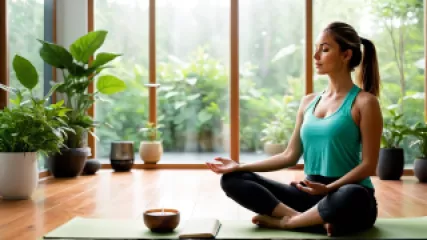Effective Self-Help Practices for Relaxation Techniques
In today's fast-paced world, finding effective ways to relax and manage stress is crucial. Below, we will explore various self-help practices for relaxation techniques that you can incorporate into your daily routine. These methods include breathing exercises, coping skills, stress-relieving exercises, and relaxation rituals.
Why Relaxation Techniques Are Important
Before diving into specific techniques, it's essential to understand why relaxation is vital. Chronic stress can lead to numerous health issues, including hypertension, anxiety disorders, and weakened immune function. By mastering relaxation techniques, you can mitigate these risks and improve your overall well-being.
Moreover, relaxation techniques help enhance mental clarity, improve emotional stability, and foster a sense of inner peace. Implementing these practices can significantly impact your quality of life.
A Brief Overview of Relaxation Techniques
Relaxation techniques vary widely, but they all aim to reduce stress and promote a state of calm. Common methods include:
- Breathing exercises: Techniques that focus on controlled breathing to calm the mind and body.
- Meditation: Practices that encourage a state of mindfulness and inner peace.
- Progressive muscle relaxation: A method that involves tensing and then relaxing different muscle groups.
- Visualization: Using mental imagery to evoke a sense of tranquility.
- Yoga: Combining physical postures with breath control and meditation.
- Aromatherapy: Using essential oils to enhance mood and relaxation.
Breathing Exercises: The Foundation of Relaxation
One of the most accessible and effective ways to promote relaxation is through breathing exercises. These techniques can be practiced anywhere and require no special equipment.
Deep Breathing
Deep breathing is a simple yet powerful technique that can quickly reduce stress and anxiety. Follow these steps:
- Sit or lie down in a comfortable position.
- Place one hand on your chest and the other on your abdomen.
- Inhale deeply through your nose, allowing your abdomen to rise while keeping your chest relatively still.
- Exhale slowly through your mouth, feeling your abdomen fall.
- Repeat for 5-10 minutes, focusing on your breath.
This exercise helps activate the body's natural relaxation response, leading to reduced heart rate and blood pressure.
4-7-8 Breathing
The 4-7-8 breathing technique, developed by Dr. Andrew Weil, is another excellent method for promoting relaxation. Here's how to do it:
- Exhale completely through your mouth, making a whooshing sound.
- Close your mouth and inhale quietly through your nose for a count of four.
- Hold your breath for a count of seven.
- Exhale completely through your mouth for a count of eight.
- Repeat this cycle three more times for a total of four breaths.
This technique helps regulate the nervous system, making it particularly useful for managing anxiety and improving sleep quality.
Coping Skills: Building Resilience Against Stress
Developing effective coping skills is essential for managing stress and enhancing resilience. These strategies enable you to handle life's challenges more effectively.
Positive Self-Talk
One of the most powerful coping skills is positive self-talk. This involves replacing negative thoughts with positive affirmations. For example, instead of thinking, "I can't handle this," tell yourself, "I am capable and strong."
Regularly practicing positive self-talk can shift your mindset, making it easier to navigate stressful situations.
Time Management
Effective time management is another crucial coping skill. By organizing your tasks and setting realistic goals, you can reduce feelings of overwhelm and increase productivity. Try using tools like planners, to-do lists, and calendar apps to stay on track.
Social Support
Building a strong support network is vital for coping with stress. Surround yourself with positive, supportive people who can offer encouragement and perspective. Don't hesitate to reach out to friends, family, or support groups when you need help.
Stress-Relieving Exercises: Physical Activities for Mental Peace
Engaging in stress-relieving exercises can significantly impact your mental and physical well-being. Regular physical activity helps release endorphins, which are natural mood boosters.
Yoga
Yoga is a holistic practice that combines physical postures, breath control, and meditation. It has been shown to reduce stress, improve flexibility, and enhance overall health. Here are some beginner-friendly yoga poses:
- Child's Pose (Balasana): A gentle stretch for the back and hips, promoting relaxation.
- Cat-Cow Pose (Marjaryasana-Bitilasana): A flowing sequence that stretches the spine and relieves tension.
- Downward-Facing Dog (Adho Mukha Svanasana): A full-body stretch that strengthens and energizes.
- Corpse Pose (Savasana): A resting pose that encourages deep relaxation and mindfulness.
Practicing yoga regularly can help you develop a greater connection between mind and body, fostering a sense of inner peace.
Walking
Taking a walk in nature can be incredibly therapeutic. Walking not only provides physical exercise but also offers an opportunity to clear your mind and connect with the natural world. Aim for at least 30 minutes of walking each day to experience its stress-relieving benefits.
Relaxation Rituals: Creating a Calming Routine
Establishing relaxation rituals can help signal to your mind and body that it's time to unwind. These rituals can become a cherished part of your daily routine.
Evening Wind-Down
Creating an evening wind-down routine can prepare you for a restful night's sleep. Consider incorporating the following activities:
- Dim the lights: Lowering the light levels signals to your body that it's time to wind down.
- Read a book: Reading a relaxing book can help distract your mind from daily stressors.
- Take a warm bath: Soaking in a warm bath can relax your muscles and calm your mind.
- Practice gratitude: Reflect on the positive aspects of your day to cultivate a sense of contentment.
By establishing a consistent evening routine, you can improve your sleep quality and overall well-being.
Morning Mindfulness
Starting your day with morning mindfulness can set a positive tone for the day ahead. Consider these practices:
- Meditation: Spend a few minutes in quiet meditation to center yourself.
- Stretching: Gentle stretching can wake up your body and improve circulation.
- Journaling: Writing down your thoughts and intentions can provide clarity and focus.
- Enjoying a healthy breakfast: Nourish your body with a nutritious meal to fuel your day.
Incorporating morning mindfulness practices can help you approach the day with a calm and focused mindset.
Self-Help Practices for Long-Term Relaxation
While immediate relaxation techniques are essential, developing long-term self-help practices can lead to sustained well-being. These practices involve making lifestyle changes that support relaxation and stress management.
Healthy Diet
Maintaining a healthy diet is crucial for overall well-being. Consuming a balanced diet rich in fruits, vegetables, lean proteins, and whole grains can provide the nutrients your body needs to function optimally. Additionally, reducing caffeine and sugar intake can help stabilize your mood and energy levels.
Regular Exercise
Engaging in regular exercise is one of the most effective ways to manage stress. Aim for at least 150 minutes of moderate-intensity aerobic activity or 75 minutes of vigorous-intensity activity each week. Exercise releases endorphins, improves sleep, and boosts overall mood.
Mindfulness Meditation
Practicing mindfulness meditation regularly can enhance your ability to manage stress and stay present. Set aside a few minutes each day to sit quietly, focus on your breath, and observe your thoughts without judgment. Over time, this practice can lead to increased emotional resilience and a greater sense of inner peace.
Quality Sleep
Getting quality sleep is essential for physical and mental health. Aim for 7-9 hours of sleep each night and establish a consistent sleep schedule. Create a relaxing bedtime routine, avoid electronic devices before bed, and ensure your sleep environment is conducive to rest.
Combining Techniques for Maximum Effectiveness
While each relaxation technique has its own benefits, combining multiple methods can enhance their effectiveness. For example, you might start your day with a morning mindfulness practice, incorporate stress-relieving exercises like yoga or walking, and end your day with an evening wind-down routine.
Experiment with different combinations to find what works best for you. Remember that consistency is key; regular practice of these techniques will yield the most significant benefits.
Personalizing Your Relaxation Practices
It's important to personalize your relaxation practices to suit your individual needs and preferences. What works for one person may not work for another, so take the time to explore different techniques and find what resonates with you.
Listen to Your Body
Pay attention to how your body responds to different relaxation techniques. If a particular method feels uncomfortable or ineffective, don't hesitate to try something else. Your body is a valuable guide in determining what works best for you.
Be Patient
Developing effective relaxation practices takes time and patience. Be gentle with yourself and allow room for experimentation and adjustment. Remember that the goal is to create a sustainable routine that promotes long-term well-being.
Additional Tips for Enhancing Relaxation
Here are some additional tips to help you enhance your relaxation practices:
- Create a calming environment: Designate a space in your home for relaxation activities, free from distractions and clutter.
- Use soothing sounds: Play calming music or nature sounds to create a peaceful atmosphere.
- Incorporate aromatherapy: Use essential oils like lavender, chamomile, or eucalyptus to promote relaxation.
- Stay hydrated: Drink plenty of water throughout the day to keep your body functioning optimally.
- Practice gratitude: Regularly reflect on the positive aspects of your life to cultivate a sense of contentment and reduce stress.
Conclusion: Embrace Relaxation as a Lifelong Journey
Relaxation is not a one-time event but a lifelong journey. By incorporating a variety of self-help practices into your daily routine, you can create a holistic approach to managing stress and promoting well-being. Remember that relaxation techniques are personal and should be tailored to fit your unique needs and preferences.
As you explore these methods, be patient with yourself and remain open to new experiences. With consistent practice and a proactive approach, you can achieve a more relaxed and balanced life.
In conclusion, mastering relaxation techniques involves a combination of breathing exercises, coping skills, stress-relieving exercises, and relaxation rituals. By integrating these practices into your daily routine, you can enhance your mental and physical well-being, build resilience against stress, and enjoy a greater sense of inner peace.






